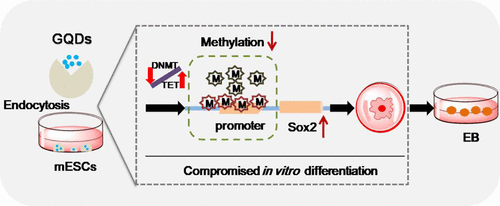当前位置:
X-MOL 学术
›
Environ. Sci. Technol.
›
论文详情
Our official English website, www.x-mol.net, welcomes your feedback! (Note: you will need to create a separate account there.)
Graphene Quantum Dots Disrupt Embryonic Stem Cell Differentiation by Interfering with the Methylation Level of Sox2
Environmental Science & Technology ( IF 11.4 ) Pub Date : 2021-02-11 , DOI: 10.1021/acs.est.0c07359 Tingting Ku 1, 2 , Fang Hao 1 , Xiaoxi Yang 1 , Ziyu Rao 1 , Qian S. Liu 1 , Nan Sang 2 , Francesco Faiola 1, 3 , Qunfang Zhou 1, 3, 4 , Guibin Jiang 1, 3, 4
Environmental Science & Technology ( IF 11.4 ) Pub Date : 2021-02-11 , DOI: 10.1021/acs.est.0c07359 Tingting Ku 1, 2 , Fang Hao 1 , Xiaoxi Yang 1 , Ziyu Rao 1 , Qian S. Liu 1 , Nan Sang 2 , Francesco Faiola 1, 3 , Qunfang Zhou 1, 3, 4 , Guibin Jiang 1, 3, 4
Affiliation

|
The tremendous potential for graphene quantum dots (GQDs) in biomedical applications has led to growing concerns of their health risks in human beings. However, present studies mainly focused on oxidative stress, apoptosis, and other general toxicity effects; the knowledge on the developmental toxicity and the related regulatory mechanisms is still far from sufficient. Our study revealed the development retardation of mouse embryonic stem cells (mESCs) caused by GQDs with a novel DNA methylation epigenetic mechanism. Specifically, GQDs were internalized into cells mainly via energy-dependent endocytosis, and a significant fraction of internalized GQDs remained in the cells even after a 48-h clearance period. Albeit with unobservable cytotoxicity or any influences on cell pluripotency, significant retardation was found in the in vitro differentiation of the mESCs into embryoid bodies (EBs) with the upregulation of Sox2 levels in GQD pretreatment groups. Importantly, this effect could be contributed by GQD-induced inhibition in CpG methylation of Sox2 through altering methyltransferase and demethyltransferase transcriptional expressions, and the demethyltransferase inhibitor, bobcat339 hydrochloride, reduced GQD-induced upregulation of Sox2. The current study first demonstrated that GQDs compromised the differentiation program of the mESCs, potentially causing development retardation. Exposure to this nanomaterial during gestation or early developmental period would cause adverse health risks and is worthy of more attention.
中文翻译:

石墨烯量子点通过干扰Sox 2的甲基化水平来破坏胚胎干细胞的分化。
石墨烯量子点(GQD)在生物医学应用中的巨大潜力已引起人们对其在人类健康方面的风险的日益关注。但是,目前的研究主要集中在氧化应激,细胞凋亡和其他一般毒性作用上。关于发育毒性和相关调节机制的知识仍然远远不够。我们的研究揭示了由具有新型DNA甲基化表观遗传机制的GQD引起的小鼠胚胎干细胞(mESCs)的发育迟缓。具体而言,GQD主要通过能量依赖性内吞作用而被内化到细胞中,即使在48小时清除期后,仍有相当一部分内在化的GQD保留在细胞中。尽管具有不可观察到的细胞毒性或对细胞多能性有任何影响,但在小鼠中发现了明显的延迟。在GQD预处理组中,通过上调Sox2的水平将mESCs体外分化为胚状体(EBs)。重要的是,这种作用可能是由GQD诱导的Sox2 CpG甲基化作用的抑制,其作用是通过改变甲基转移酶和去甲基转移酶的转录表达来实现的,去甲基转移酶抑制剂bobcat339 hydrochloride降低了GQD诱导的Sox2的上调。当前的研究首先表明,GQD损害了mESC的分化程序,可能导致发育迟缓。在妊娠或发育初期暴露于这种纳米材料会造成不利的健康风险,值得更多关注。
更新日期:2021-03-02
中文翻译:

石墨烯量子点通过干扰Sox 2的甲基化水平来破坏胚胎干细胞的分化。
石墨烯量子点(GQD)在生物医学应用中的巨大潜力已引起人们对其在人类健康方面的风险的日益关注。但是,目前的研究主要集中在氧化应激,细胞凋亡和其他一般毒性作用上。关于发育毒性和相关调节机制的知识仍然远远不够。我们的研究揭示了由具有新型DNA甲基化表观遗传机制的GQD引起的小鼠胚胎干细胞(mESCs)的发育迟缓。具体而言,GQD主要通过能量依赖性内吞作用而被内化到细胞中,即使在48小时清除期后,仍有相当一部分内在化的GQD保留在细胞中。尽管具有不可观察到的细胞毒性或对细胞多能性有任何影响,但在小鼠中发现了明显的延迟。在GQD预处理组中,通过上调Sox2的水平将mESCs体外分化为胚状体(EBs)。重要的是,这种作用可能是由GQD诱导的Sox2 CpG甲基化作用的抑制,其作用是通过改变甲基转移酶和去甲基转移酶的转录表达来实现的,去甲基转移酶抑制剂bobcat339 hydrochloride降低了GQD诱导的Sox2的上调。当前的研究首先表明,GQD损害了mESC的分化程序,可能导致发育迟缓。在妊娠或发育初期暴露于这种纳米材料会造成不利的健康风险,值得更多关注。



























 京公网安备 11010802027423号
京公网安备 11010802027423号